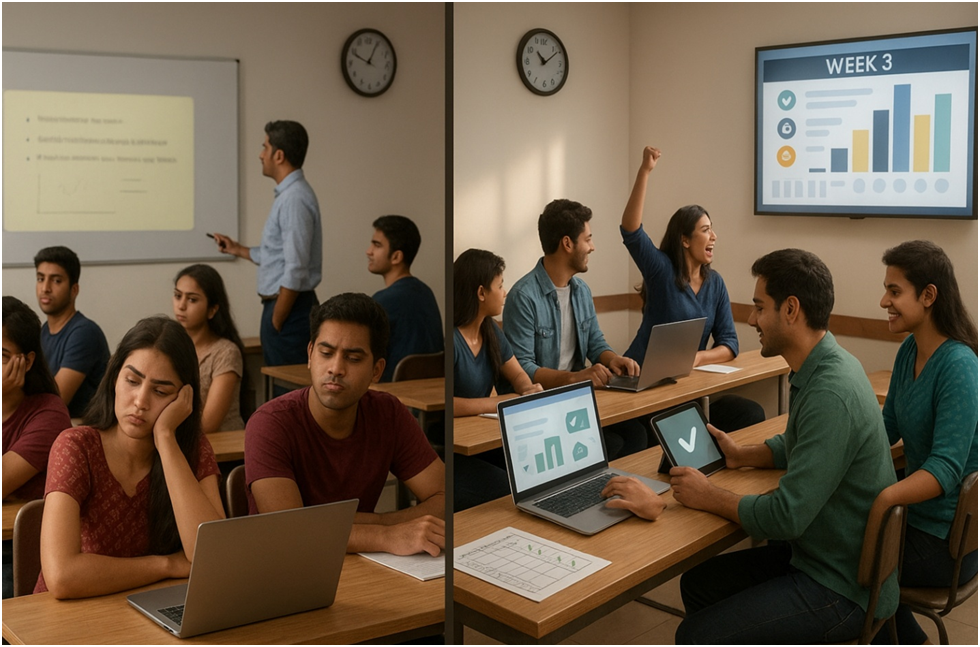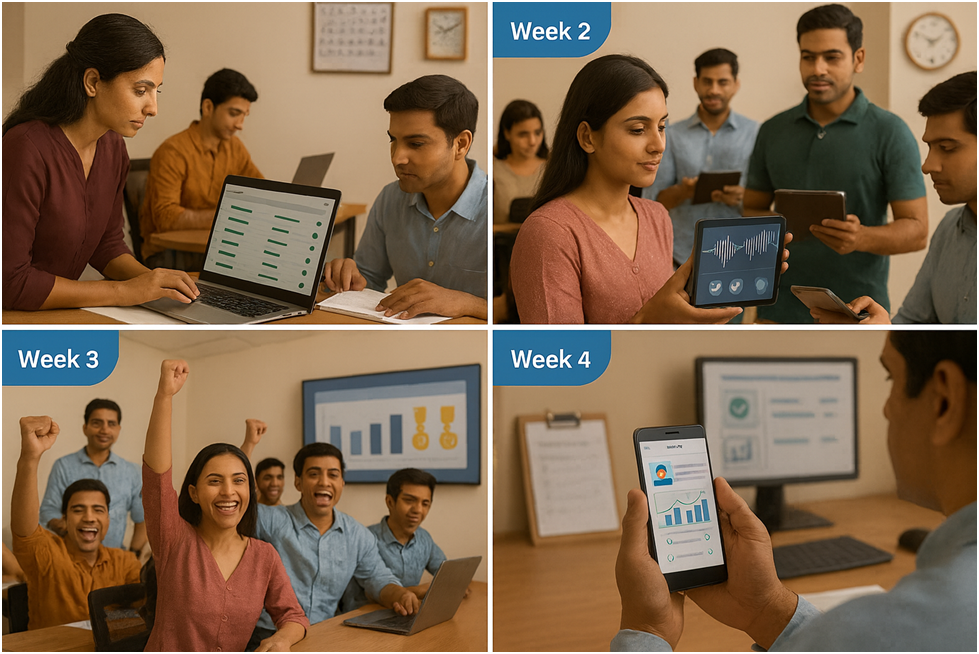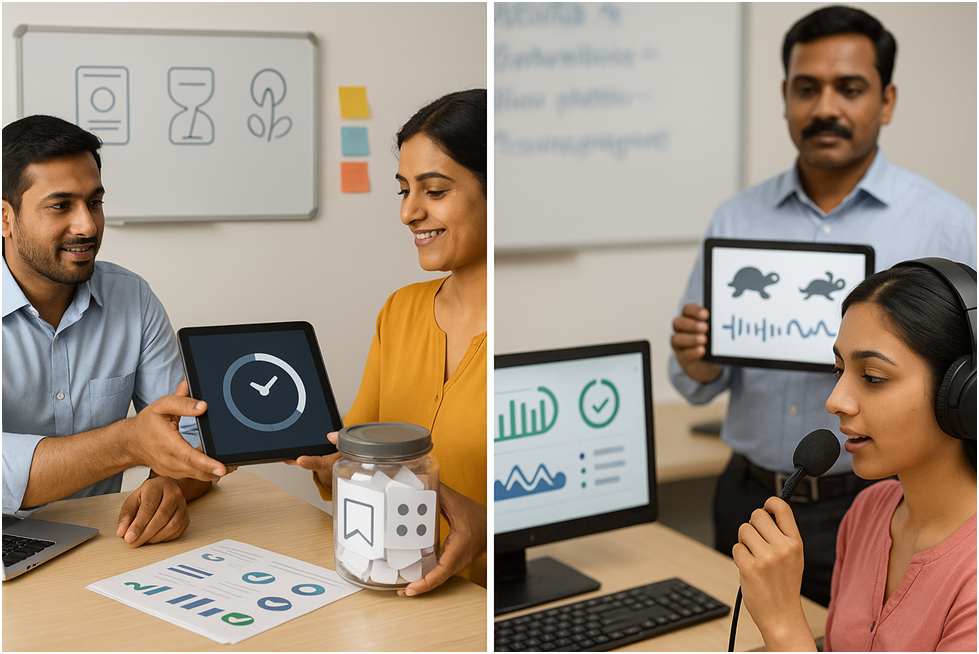| Choose Exam Category |

For Heads of Academics who manage multiple centers and want attendance, completion, and scores to rise together.
Students are not skipping because they lack discipline. They are skipping because the learning experience does not reward effort fast enough.
If Week-3 attendance dips across branches, you have a content problem, not a culture problem.
Start with a five-question health check
Pull data for the last two fresh batches per center.
1. Week-3 attendance by batch
2. Median time from attempt to feedback
3. Practice minutes per learner per week
4. "Mock feels like the real test" rating from students
5. Percent of learners who can name their top two weak skills
If three or more are weak, your materials are not pulling their weight.

-----------------------------------------------------------------------------------------
A quick story from the field
Two branches ran the same long lectures and static notes. Toppers were bored. Strugglers felt lost. Attendance slid after Week-2.
The Academic Head of one mademade three simple moves. One long lesson each week became three 10-minute drills. Instant AI feedback was turned on
with a tiny remedial pack for each attempt. A Saturday live mock with a branch leaderboard created buzz. By Week-3, attendance rose, feedback
landed under 24 hours and Instant AI feedback caught the fancy of students, and more learners could clearly say what to fix next. Faculty time
shifted from blanket reteaching to targeted coaching. You can replicate this in 30 days.

------------------------------------------------------------------------------------
Five shifts that stop ghosting
1) Make the "content" breathe
The change. Move from long lessons and passive notes to micro-lessons and short, test-like drills that adapt to level. Bury vocabulary, collocations, spelling, and applied grammar inside practice using QR codes.
Start most learners on topic-wise and sectional tests. Keep full mocks for rhythm and benchmarking.
How to run it this week. Break a unit into three 10-minute teach-practice loops. End each loop with two fresh items that use the skill in context. Ask learners to save tricky words during review.
Signals to watch. Week-3 attendance, practice minutes, revision streaks, and the share of learners who can name two weak skills.
Quiet enabler. A large, skill-tagged test bank with a custom test builder like TCY's test generator and an upload-your-own options where required.
Printed Smart Books that deep-link to the exact item on the mobile app through a QR code.
2) Feedback in seconds, not days
The change. Give instant scoring aligned to official rubrics with smart AI learning assistants like TCY's Ena. Attach a small, auto-generated remedial pack.
Keep a teacher panel with rubrics for quick overrides and notes. In speaking, let learners compare with a model answer and adjust playback speed.
Why it works. Effort maps to progress the same day. Students return because they can fix one thing now. Teachers stop reteaching everything and focus on the few patterns that matter.
Signals to watch. Median time taken to seek feedback, remedial completion, and the post-remedial score lift.

3) Practice must feel like the real exam
The change. Mirror the interface, timers, calculator, navigation, and item mix for each test. Offer both linear and adaptive flows where relevant. Use sectional locks when the exam demands a fixed path.
Why it works. Realism reduces anxiety and procrastination. Homework completion rises because the effort feels exam-relevant.
Signals to watch. Student rating of "mock feels like the real test," first-attempt confidence in labs, and completion of assigned sectionals.
4) Belonging beats willpower
The change. Run weekly challenge ladders and center leaderboards. Host one live mock day across branches each month. Make small wins public on your WhatsApp and parent groups.
Why it works. Social proof creates momentum. Topper energy lifts the middle. The quiet learner has a reason to return next week.
Signals to watch. Challengezone participation, comeback rate after nudges, and live-event attendance.
5) Mobile first, or it will not happen
The change. Design for daily bite-size practice, streaks, and push nudges tied to each learner's weak skills. Share one-tap micro-reports that parents can view.
Link print to phone with QR so revision starts where reading stops.
Why it works. Learning competes with a phone. Win on the phone and practice shows up every day.
Signals to watch. Day-7 active learners, streak length, mobile minutes, and parent views of micro-reports.

--------------------------------------------------------------------------------------------------------------------------------------------
What your "Center Health" page should show
Build a one-page view you can scan every Monday.
• Week-3 retention by batch
• Feedback time lag median and outliers
• Skill mastery heatmap by center, program, and faculty
• Predicted score trend alongside actual movement
• Challenge participation and comeback rate after nudges
• Exceptions for attendance dips, fee issues, and unresolved complaints
Add filters for center, program, faculty, and date range. Allow drill-downs from center to batch to learner. When you can see it in one glance, you can fix it in one meeting.

----------------------------------------------------------------------------
A 30-day pilot you can run
Goal. Lift Week-3 attendance by a clear single-digit to low double-digit range. Cut feedback lag to under 24 hours.
Playbook.
Week 1. Swap one long lesson for three micro-drills with instant scoring. Start save-word routines in reviews.
Week 2. Turn on model-answer compare and slower playback for speaking review.
Week 3. Host a Saturday live mock with a branch leaderboard.
Week 4. Send two weak-skill nudges per learner each week. Share a two-line parent micro-report every Friday.
Measure. Attendance, practice minutes, remedial completion, post-remedial score lift, mock realism rating, challenge participation, and the share of learners who can state two weak skills.
Publish the numbers to all branches. Scale what works.

----------------------------------------------------------------------------
Faculty handovers that take pressure off
• The 10-minute micro-debrief. One pattern spotted, one fix, two fresh items.
• The save-word routine. Save tricky words during analysis. Open the next class with a two-minute quiz from that list.
• Mock to mastery. Show the gap against the model answer. Record once at 0.8x speed to focus on clarity, then once at normal speed.
These are simple, repeatable, and immediately visible in your dashboard.

----------------------------------------------------------------------------
Objections you will hear, with better responses
"Our books are already great." Keep them. Make them interactive with QR and app follow-ups so they guide practice, not just reading.
"Teachers do not have time for new tools." Use ready templates and auto-remedials. By Week-2, class time is saved.
"Can we trust AI scores." Use AI for speed and consistency. Keep a teacher override and sample-based audits.
"Parents only care about marks." Show short weekly trends and one fix per learner. Parents value visible movement.
----------------------------------------------------------------------------
A quiet due-diligence checklist for your platform
• Exam-faithful interfaces with both linear and adaptive engines
• Instant AI evaluation aligned to official rubrics with predicted score ranges
• Auto-generated remedials and a teacher evaluation panel with rubrics
• Topic-wise, sectional, custom tests, and upload-your-own with analytics
• iOS and Android app with reports, answer sheets, e-books, and QR that links print to practice
• Challenge ladders, live mock support, and branch comparisons
• Personalized branding across domain, app, and print
A platform like TCY already covers these edges, so your team can focus on teaching rather than tooling.
----------------------------------------------------------------------------
Your next move
Pick one batch. Run the 30-day pilot. Put the Center Health view on your Monday meeting agenda. When the numbers move, standardize the play across every center.
Students do not skip great experiences. Build those experiences and attendance takes care of itself.
